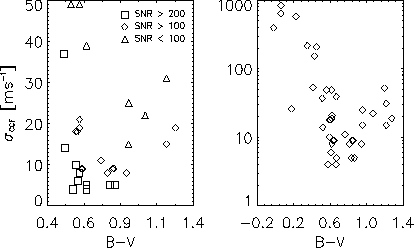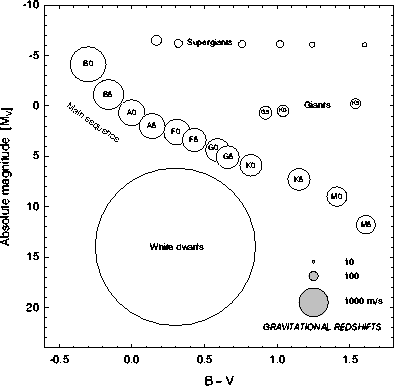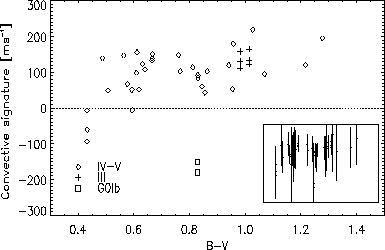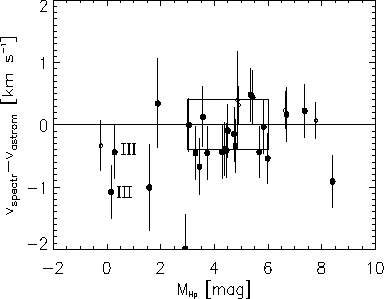
Dag GULLBERG, Dainis DRAVINS, Lennart LINDEGREN, Søren MADSEN
Lund Observatory, Box 43, SE-22100 Lund, Suède
The wavelengths of features in stellar spectra do not depend only on the star's velocity. This program aims at studying lineshifts caused by other effects, in particular due to stellar surface structure and gravitational redshift, and also to improve the absolute accuracy in radial-velocity measurements.
For the Sun, a convective blueshift of about 300 m/s results from correlated velocity and brightness patterns: rising (blueshifted) granulation elements are hotter and brighter than sinking ones.
Accurate absolute lineshifts (i.e. displacements of spectral line wavelengths from their laboratory values, corrected for the relative object-observer motion) had until previously been measured only for the Sun. Solar motion is known from planetary system dynamics and does not depend on spectroscopic data. Thus, solar lineshifts can be interpreted as originating from gravitational redshift (636 m/s), convective blueshifts, pressure shifts, and other atmospheric phenomena [Dravins 1998].
Space astrometry now enables astrometric determinations of stellar radial motion, permitting the study of absolute lineshifts also for other stars. On Hipparcos, an observing program has been carried out for the Ursa Major association and the Hyades open cluster, reaching accuracies of about 100 m/s and 300 m/s respectively [Madsen et al. 1999b], [Madsen et al. 1999a].
The corresponding spectroscopic program has been carried out at the OHP 1.93 m telescope, using the ÉLODIE radial-velocity spectrometer. In 1997 (February and October), Dravins and Gullberg made observations during a total of 15 nights. The program stars included such of widely different spectral types, not only cluster stars observed for astrometric radial velocity, but also the Moon and a number of IAU radial-velocity standards.
The software of ÉLODIE gives in pseudo-real-time the radial velocities for an F0 and a K0 mask. Adding to these results we have computed radial velocities based a spectral atlas of integrated solar-light, i.e. [Kurucz et al. 1984], using in-house developed software.
After inspecting the calibration information we have concluded that the instrumental errors behave like a random-walk process, more evident in data from October, than in February, which has been used to estimate errors due to the drift in the calibration. Correction terms have also been computed to handle drifts during the extent of the integration time.
The collected flux over time is of course a limiting factor and uncertainties have been estimated using the curvature of the cross-correlation function (CCF) and the signal-to-noise ratio (SNR) of the data locally, see Figure 1 . The velocity itself is computed by taking the three top most points of the CCF and letting them define a parabolic function. The sought for velocity is then at the maximum of this function [Gullberg 1998a].

Figure 1: Estimated errors in the determination of the maximum
of the cross-correlation function (CCF) for mainly main sequence stars.
Left: Shown for different intervals of SNR.
Right: The error grows exponentially towards earlier stars.
The light emanating from a stellar atmosphere struggle to escape the potential well caused by the stellar mass, as predicted by relativity theory. The amount of redshift for the photons is given by the expression Vgrav = GM/Rc, where G is the universal gravitational constant, M the mass of the star, R the radius of the star and c the velocity of light in vacuum. Using the Sun as an example we have Vgrav = 636 m/s for light escaping to infinity and Vgrav = 633 m/s at the Earth [Dravins 1998]. In Figure 2 is shown how the gravitational redshifts vary in the HR-diagram.

Figure 2: Theoretically expected gravitational redshifts in an HR-diagram, with the symbol area proportional to the amount of shift.
The granular structure of the Solar surface gives rise to asymmetries in the spectral lines, with the hot, bright uprising granular centra causing light to be blueshifted while the cool, darker, inter-granular lanes with down falling gas, cause light to be red-shifted. The net effect for the Sun in integrated light is a blue shift of about 300-400 m/s. A similar behavior is expected for solar like stars on the main sequence, while in hotter or more luminous stars, these effects are expected to be greater (e.g., [Dravins & Nordlund 1990], [Dravins 1998]).
In Solar-like stars, deep FeI lines have, on average, less convective shifts than shallow ones. Synthetic templates, based on the FeI line-list of Nave et al. (1994) have been correlated with the stellar spectra and thus velocities for the deep line-set and the shallow line-set were computed. The difference, c.s. = Vdeep- Vshallow, the convective signature, is plotted for a selection of stars in Figure 3 [Gullberg 1998b]. Note that the convective signature is independent of the radial velocity itself of the star, drift in wavelength zero-point (at time scale of the order of the integration time), gravitational redshifts, etc. A major instrumental requirement is that the wavelength scale has a high degree of internal integrity.

Figure 3: Convective signatures for a selection of stars.
Note the significant difference between the G0 supergiants and solar like stars.
(See Gullberg 1998b)
High-precision astrometric observations of stars permit not only their tangential velocities (proper motions) but also their line-of-sight motions to be determined. Three different concepts are outlined in Lindegren et al. (1999a) and briefly in Madsen et al. (1999b), of which one of them, the moving cluster method, is applied for a number of clusters in Madsen et al. (1999a) first described in Dravins et al. (1997). Using a maximum likelihood estimation method, the radial velocities of individual stars in open clusters like the Hyades and the Ursa major group have been determined. This, the astrometric, radial velocity could be perceived as being the true center of mass motion in the line of sight. Furthermore, the method yields also improved parallaxes which result in a very well defined HR-diagram and absolute magnitudes (Hipparcos system magnitudes, MHp) (Madsen et al. 1999b, Madsen 1999). The fact that the main sequence stars lie practically on a line is a confirmation of the parallax improvement an the reliability of the astrometric radial velocities.
Knowing both precise spectroscopic and astrometric radial velocities give us the opportunity to reveal physical phenomena in the stellar atmospheres. Removing the center of mass velocity, we have only effects from convective blueshift, gravitational redshift, (planetary) companions, oscillations/pulsations and stellar cycle effects. Assuming that we are not dealing with multiple system and that we are looking at normal stars, most of these effects are negligible, while the convective blueshift is expected to vary from -1000 to -200 m/s for stars between F5 to K0 on the main sequence [Dravins & Nordlund 1990]. Since the gravitational redshift is fairly constant in this regime, about 650 m/s, the net effect will vary roughly between [-400, +400] m/s for stars in the range of F5V to K0V .

Figure 4: When removing the center of mass motion in the line of sight from the measured spectroscopic radial velocity, we are left with, mainly, the sum of convective and surface gravity components. It is believed to vary between -400 to +400 m/s in the spectral type range F5 to K0 for main sequence stars (indicated by the box). Filled circles are Hyades stars, the others are stars in the Ursa Major group.
The fact that the net effect of gravitational redshift and convective blueshift amounts to ±400 m/s for stars in the range F5V to K0V should be alarming to anyone aiming at accurate radial velocities. Add to this other stellar-atmosphere effects, choice of mask when correlating, and more subtle effects that arise from relativistic effects as described in Lindegren et al. (1999b). By compensating for the convective and surface gravity effects the accuracy could be improved by one order of magnitude, putting it on the same order of magnitude as the precision for many instruments of today [Gullberg 1998a].
The uncertainties in the convective signatures in Figure 3 are large (see the inset in the figure), but this is a preliminary investigation containing only a total of 287 FeI lines, based on a constant linedepth criterion for the deep and shallow line selection (as found in high resolutions spectral atlases). Work has shown (e.g. [Nadeau 1988], [Hamilton & Lester 1998]), that there is a wavelength-dependence on line-shifts for a given line-depth and element. This will be taken into account in the continued work, and larger sets of lines will be used to better map out the convective signatures of the stars in the regime F5 to K0.
The astrometric radial velocities are expected to be improved over the next
two decades. ESA is currently reviewing projects for cornerstone missions
and the astrometric satellite GAIA
[Lindegren & Perryman 1996]
is one of the contenders. This satellite would reach accuracies of the order of
![]() for parallaxes and proper-motions but also cover a large set of stars, reaching
distance as far as to the center of the Galaxy for bright stars. The improved
accuracies for the astrometric parameters and the large dataset will in turn
improve the accuracies of the astrometric radial velocities.
for parallaxes and proper-motions but also cover a large set of stars, reaching
distance as far as to the center of the Galaxy for bright stars. The improved
accuracies for the astrometric parameters and the large dataset will in turn
improve the accuracies of the astrometric radial velocities.
A further program description is available on the World-Wide-Web:
http://www.astro.lu.se/~dainis/HTML/ASTROMET.html
Dravins & Nordlund, 1990
Dravins D., & Nordlund Å., 1990, A&A 228, 203
Dravins et al., 1997
Dravins D., Lindegren L., Madsen S., Holmberg J., 1997, in Proc. Hipparcos -
Venice '97, ESA SP-402, p.733
Dravins, 1998
Dravins D., 1999, in IAU Colloquium 170, Precise stellar radial velocities,
ASP Conference Series, eds. Hearnshaw J. B., and Scarfe C. D., in press
Dravins et al., 1998
Dravins D., Gullberg D., Lindegren L., Madsen S., 1999, in IAU Colloquium 170,
Precise stellar radial velocities, ASP Conference Series,
eds. Hearnshaw J. B., and Scarfe C. D., in press
Gullberg, 1998a
Gullberg D., 1999, in IAU Colloquium 170, Precise stellar radial velocities,
ASP Conference Series, eds. Hearnshaw J. B., and Scarfe C. D., in press
Gullberg, 1998b
Gullberg D., 1999, in IAU Colloquium 170, Precise stellar radial velocities,
ASP Conference Series, eds. Hearnshaw J. B., and Scarfe C. D., in press
Hamilton & Lester, 1998
Hamilton D., Lester J. B., 1998, Tenth Cambridge Workshop on Cool Stars,
Stellar Systems, and the Sun, ASP Conference Series, eds. Donahue R. A. &
Bookbinder J. A.
Kurucz et al., 1984
Kurucz R. L., Furenlid I., & Brault J., 1984, Solar Flux Atlas from 296 to
1300nm, National Solar Observatory.
Lindegren & Perryman, 1996
Lindegren L., Perryman M. A. C., 1996, A&AS, 116, 579
Lindegren et al., 1999a
Lindegren L., Dravins D., Madsen S., 1999, A&A, in preparation
Lindegren et al., 1999b
Lindegren L., Dravins D., Madsen S., 1999, IAU Colloquium 170, Precise stellar
radial velocities, ASP Conference Series, eds. Hearnshaw J. B., and Scarfe C. D.,
in press
Madsen et al., 1999a
Madsen S., Dravins D., Lindegren L., 1999, A&A, in preparation
Madsen et al., 1999b
Madsen S., Lindegren L., Dravins D., 1999, in IAU Colloquium 170, Precise stellar
radial velocities, ASP Conference Series, eds. Hearnshaw J. B., and Scarfe C. D.,
in press
Madsen, 1999
Madsen S., 1999, in Harmonizing Cosmic Distance Scales in a Post Hipparcos Era,
ASP Conference Series, eds. Egret D. and Heck A., in press
Nadeau, 1988
Nadeau D., 1988, ApJ, 325, 480
Nave et al., 1994
Nave G., et al., 1994, ApJS, 94, 221.